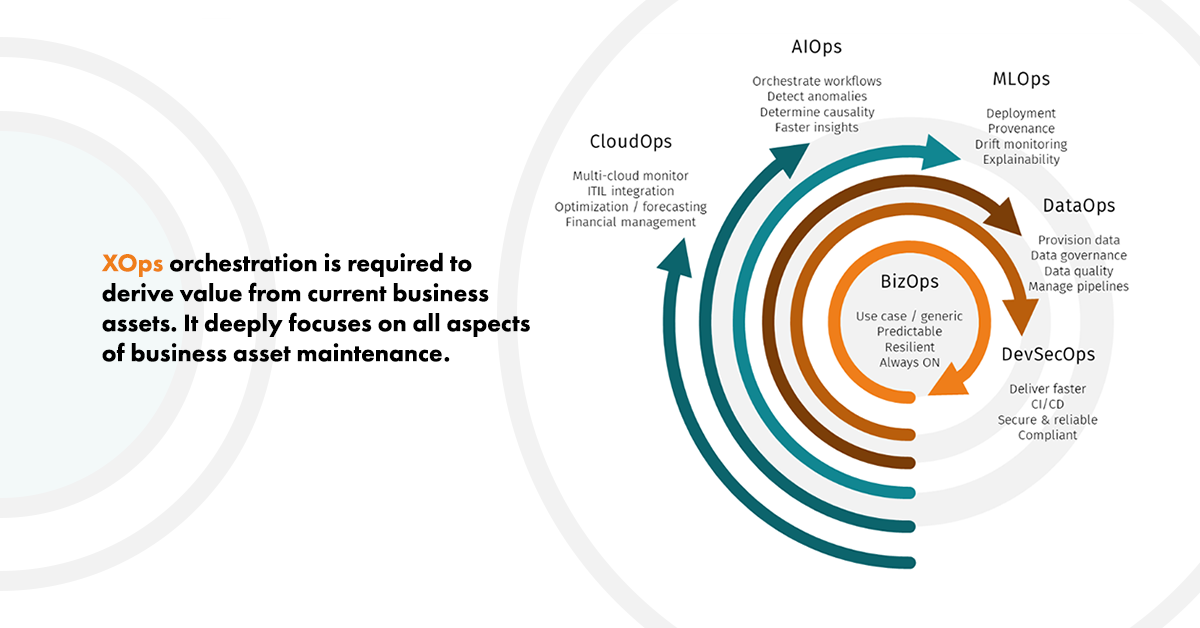
Contemporary business applications face challenges on multiple fronts. A XOps approach will help organizations stay ahead. Contemporary organizations rely on business applications to help make critical decisions. Data about the business, competitors, the environment, and more are visualized in multiple ways. Coupled with data filters, these applications give corporate executives the power to analyze the data, derive insights, and drive value to the business.
Complex nature of contemporary business applications
Gone are the days when business applications were mere front-end views reading off relational databases, and the only variable to worry for developers and application owners was code changes. In fact, it is the need to monitor and deploy this code the right way that gave raise to DevSecOps, which focused on making the process of code development, deployment, and delivery to production secure and reliable. The emergence of cloud-based infrastructure and tools, along with technological advancements across the business application value chain, have made the process of managing business applications much more complex. Business applications are no longer just code, but also include multiple data pipelines and AI/ML models. Thanks to the global connectivity boom, the code, data, security, and ML aspects, all have to be stitched together the right way and made to work seamlessly, to ensure continued value creation for enterprises.
Gone are the days when business applications were mere front-end views reading off relational databases, and the only variable to worry about for developers and application owners was code changes.
Production business applications: Expectations vs Reality
End-users expect production business applications to be resilient, always available, and consistent in the insights they present. However, these applications always compete with other production applications for server resources, and budget constraints always force support teams to pick one application over the other for fixing which jeopardizes users’ trust in the application that wasn’t prioritized. Containerization and modularization are expected to be the order of the day on the deployment and security front. However, clunky codes and too many APIs in production make this a very complex and cumbersome process. With the proliferation of internal and third-party data sources, managing the data feed into applications becomes important. Users expect high-quality data, with self-service discovery and the ability to trace data lineage easily, but ownership conflicts around data sources and poor workload management of data pipelines lead to data being underutilized. AI/ML has helped transform the depth and range of insights that business applications can provide. ML models can exponentially alter the impact of applications on business decisions. However, if not tracked properly, the same ML models can drift and severely impede decision making. . ML model performance tracking (and the skills to track the same) still remains a big gap. With code, data, ML, and security becoming important, the need for a layer that stitches all of them together is also required. This operational layer must also allow integration with ticketing systems for rapid issue detection, tracking, and resolution across all moving parts. But such integrations and automation remain inconsistent in the real world. Lastly, all the above components now sit on public and private clouds, and the need thus arises for optimizing costs and scaling the apps up or down on demand. But clouds are still managed reactively, with no centralized reporting. We thus see a huge gap between expectations and reality, which needs to be bridged to regain end users’ trust and drive continued value from production business apps.
Enter XOps
Gartner names XOps as trend number 5 in its ‘Top 10 data and analytics trends for 2021’. Per Gartner, XOps seeks to achieve efficiencies and economies of scale across the value chain using best practices of DevOps, ensuring reliability, reusability, and repeatability. But XOps is much more than just that.
We see a huge gap between expectations and reality, which needs to be bridged to regain end users’ trust and drive continued value from production business apps.
XOps begins with the core business application and ensuring its stability – we call this BizOps. Without this core, the entire business value chain collapses and ceases to make sense. At the next level, we have DevSecOps which ensures the business applications in production continue to stay relevant while adhering to security norms. DataOps then addresses the plethora of data inputs flowing into the production application (across environments) and the maintenance of the same. Likewise, MLOps focuses on maintaining the ML models within an application if present. AIOps then stitches together all these layers to ensure a seamless experience in maintenance, rapid issue identification, and resolution. Finally, CloudOps enables all these layers to optimally fit on the cloud.

XOps can thus help remove organization silos and drive improved collaboration between software developers, data engineers, data scientists, and IT administrators. XOps can also drive improved automation across these groups by defining the rules of operation and monitoring KPIs to track overall program effectiveness.
In conclusion
Tredence helps organizations set up their production business applications for XOps and run the same at scale, through a combination of cross-skilled people, strong partnerships, and the right accelerators for each point in the value chain. In the next article in this 8-part series, we will focus on BizOps and how Tredence adds value to its customers in this space. If you are feeling overwhelmed managing all aspects of your production apps, or just want to discuss your XOps requirements with us, write to us at marketing@tredence.com to discuss further. Let’s get the conversation started!

AUTHOR - FOLLOW
Sanat Pai Raikar
Associate Principal
Topic Tags




